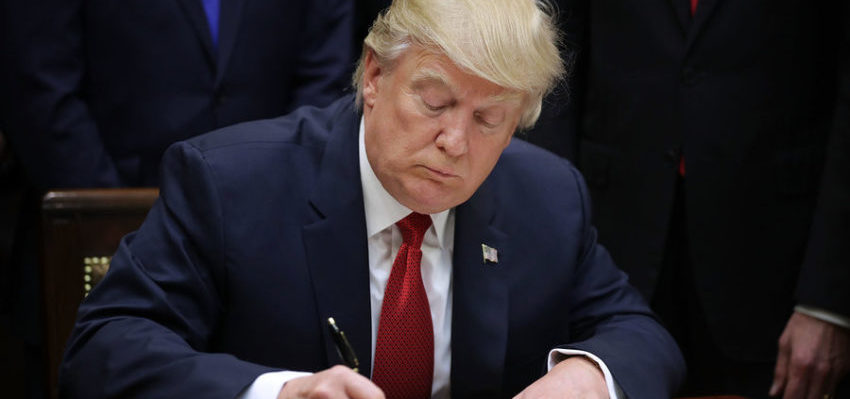 Trump’s Order on Economic Mobility “takes the first steps toward welfare reform in America” and signals to states like Wisc. that the White House is serious about fixing the nation’s troubled welfare system. #wiright #wipolitics Click To Tweet
Trump’s Order on Economic Mobility “takes the first steps toward welfare reform in America” and signals to states like Wisc. that the White House is serious about fixing the nation’s troubled welfare system. #wiright #wipolitics Click To Tweet
MacIver News Service | April 12, 2018
By M.D. Kittle
MADISON, Wis. – Amid the din of D.C. intrigue, President Donald Trump this week issued an executive order aimed at fighting poverty while protecting taxpayers.
“We can lift our citizens from welfare to work, from dependence to independence, and from poverty to prosperity,” said President Donald Trump.
And the initiative appears to bode well for Wisconsin’s latest welfare reform package.
The president’s Order on Economic Mobility “takes the first steps toward welfare reform in America” and signals to states like Wisconsin that the White House is serious about fixing the nation’s troubled public assistance system.
“We can lift our citizens from welfare to work, from dependence to independence, and from poverty to prosperity,” Trump said.
The president’s rhetoric echoes that of Gov. Scott Walker, a two-term Republican governor who has, in many ways, led nationally on welfare reform.
On Tuesday, as Trump was issuing the executive order, Walker signed into law nine measures expanding the state’s welfare-to-work initiatives. The reform package, among other changes, increases work requirements and creates a health savings account-style Medicaid program that could be a huge savings for taxpayers.
Walker’s administration is seeking a federal waiver to require able-bodied adults, including parents of school-aged children, to spend 30 hours per week working or training for work in order to receive FoodShare and BadgerCare (Wisconsin’s Medicaid program) benefits. Currently, able-bodied adults must spend at least 20 hours per week at a job or training for one in order to receive the taxpayer-funded benefits.
Last month, state Sen. Chris Kapenga (R-Delafield) met at the White House with Trump’s special adviser on Medicaid, and deputy secretaries of the U.S. Department of Health and Human Services and the Centers for Medicare & Medicaid Services. The administrators, Kapenga said, were very receptive to Wisconsin’s proposals.
Trump’s executive order, it would seem, only enhances the chances Wisconsin’s federal wavier requests will be approved.
Trump’s executive order, it would seem, only enhances the chances Wisconsin’s federal wavier requests will be approved.
“(Tuesday’s) executive order demonstrates that the Trump administration is looking to the states to be leaders on welfare reform, and Wisconsin is leading the way,” Kapenga, who was Senate co-author of the bills, told MacIver News Service.
Among its other directives, the president’s order provides “more flexibility to the States, while ensuring accountability for achieving outcomes.”
“The principles and policies laid out in the President’s executive order are very much aligned with the Wisconsin Works for Everyone package, which gives us hope the federal government will ultimately give us the flexibility needed to implement our reforms,” Kapenga said in a statement to MacIver.
Speaker Paul Ryan (R-Janesville) on Tuesday tweeted that in one of the best economic environments in years businesses are struggling to find qualified workers.
“@POTUS’s executive order on workforce development and economic mobility reaffirms that it’s time we face our poverty challenge head on,” Ryan tweeted.
The initiative provides nine “Principles of Economic Mobility,” which are to guide federal agencies that administer public assistance programs, according to the executive order. They must:
- Improve employment outcomes and economic indepencence
- Promote marriage and family as a way of escaping poverty
- Address the challenges of hard-to-employ populations
- Provide more flexibility to states, while ensuring accountability for achieving outcomes
- Streamline services to more effectively use taxpayer resources
- Reserve benefits for those truly in need
- Consolidate duplicative programs
- Facilitate greater sharing of information between states and localities
- Empower the private sector to find solutions to poverty
While the reform order moves to empower state, local, and tribal governments to serve needy individuals and families, it emphasizes strengthening work requirements and assuring public assistance goes to those truly in need.
Last year, the federal government – via taxpayers – spent more than $700 billion on welfare programs.
Last year, the federal government – via taxpayers – spent more than $700 billion on welfare programs.
Public assistance and big government advocates blasted the executive order.
“Work requirements are inconsistent with the realities of poverty in America and are unlikely to provide any resolution,” Valerie Wilson, director of the Program on Race, Ethnicity and the Economy at the liberal Economic Policy Institute, told the Washington Post.
But proponents of welfare reform in Wisconsin say expanded work and training requirements for public assistance are bringing success. According to the most recent figures from the state Department of Health Services, requiring recipients work or enroll in job training programs 20 hours per week has helped more than 25,000 participants gain employment – with an average wage of $12.68 per hour.
“Wisconsin is leading the nation on welfare reform,” Walker said in a statement Tuesday, after signing the welfare reform legislation into law. “We want to help those in need move from government dependence to true independence through the dignity of work.”